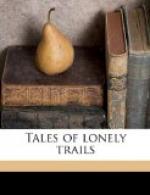Frost was late this fall. The acorns had hardly ripened, the leaves had scarcely colored; and really good bear hunting seemed weeks off. A storm and then a cold snap would help matters wonderfully, and for these we hoped. Indeed the weather had not settled; hardly a day had been free of clouds. But despite conditions we decided to start in bear hunting every other day, feeling that at least we could train the pack, and get them and ourselves in better shape for a favorable time when it arrived.
Accordingly next day we sallied forth for Horton Thicket, and I went down with Edd and George. It was a fine day, sunny and windy at intervals. The new trail the boys had made was boggy. From above Horton Thicket looked dark, green, verdant, with scarcely any touch of autumn colors; from below, once in it, all seemed a darker green, cool and damp. Water lay in all low places. The creek roared bankfull of clear water.
The new trail led up and down over dark red rich earth, through thickets of jack-pine and maple, and then across long slopes of manzanita and juniper, mescal and oak. Junipers were not fruitful this year as they were last, only a few having clusters of lavender-colored berries. The manzanita brush appeared exceptionally beautiful with its vivid contrasts of crimson and green leaves, orange-colored berries, and smooth, shiny bark of a chocolate red. The mescal consisted of round patches of cactus with spear-shaped leaves, low on the ground, with a long dead stalk standing or broken down. This stalk grows fresh every spring, when it is laden with beautiful yellow blossoms. The honey from the flowers of mescal and mesquite is the best to be obtained in this country of innumerable bees.
Presently the hounds opened up on some kind of a trail and they worked on it around under the ledges toward the next canyon, called See Canyon. After a while the country grew so rough that fast riding was impossible; the thickets tore and clutched at us until they finally stopped the horses. We got off. Edd climbed to a ridge-top. “Pack gone way round,” he called. “I’ll walk. Take my horse back.” I decided to let George take my horse also, and I hurried to catch up with Edd.
Following that long-legged Arizonian on foot was almost as strenuous as keeping him in sight on horseback. I managed it. We climbed steep slopes and the farther we climbed the thicker grew the brush. Often we would halt to listen for hounds, at which welcome intervals I endeavored to catch my breath. We kept the hounds in hearing, which fact incited us to renewed endeavors. At length we got into a belt of live-oak and scrub-pine brush, almost as difficult to penetrate as manzanita, and here we had to bend and crawl. Bear and deer tracks led everywhere. Small stones and large stones had been lifted and displaced by bears searching for grubs. These slopes were dry; we found no water at the heads of ravines, yet the red earth was rich in bearded, tufted grass, yellow




